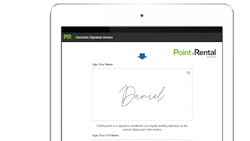RER talks with Wayne Harris, CEO, Point of Rental Software, about its Inspection App and other tools; telematics’ alerting capabilities; short-term and long-term developments, and more.
What are the new developments in your rental software since we last had these interviews a year ago?
Harris: Our Inspection App, which moves the maintenance process and its checklists online for easy-to-track accountability, is really getting attention for its ease of use. We’ve implemented our own digital signature software, which shifts even more paperwork online and makes filing incredibly easy.
Rental Elite was mobile-accessible this time last year, but now it’s truly mobile-friendly, with searchable report lists, new widgets like Fleet Utilization and Driver/Route on-time reporting, and intuitive charts that use responsive design to allow for easy viewing on every device.
Rental Elite’s new built-in CRM gives the sales teams mobile access to a prospect or customer’s rental history, billing history, quotes, and other data. It’s much easier than using a remote connection to get into the system.
Our cloud software product, Rental Essentials, has added several more features, including transaction, item, and customer tagging, and added integrations with payment processors like Cayan and Moneris.
As telematics grows in importance in the rental industry, the relationship between telematics and rental software is important. Can you talk about the integration between your software and telematics systems?
Harris: For several years, Point of Rental has offered features that integrate with TSO Mobile’s GPS- and fleet-tracking systems to allow managers to see routes, track drivers in real time, see odometers or hour meters, and so on. As the use of telematics has grown, we’ve added features that provide practical information to alert rental stores to take action before a problem occurs, such as to call equipment off rental or send out a mechanic before it’s damaged. We always try to stay ahead of the technology curve, so we are constantly thinking of ways that rental companies can benefit from machine data and how we can implement that in our software.
One of the challenges rental companies face is figuring out the level of profitability of each piece of equipment, and each equipment segment. How can your software help with that challenge?
Harris: Reporting is a critical part of rental software, which is why we provide reporting on key performance indicators like ROI, dollar and time utilization, future reservation value, etc. These reports are based on each item’s rental and maintenance history, and really help you figure out whether it’s time to sell or if you should keep your equipment for another season.
Another challenge for rental companies is the profitability of bidding on a job, and what type of rate makes sense for them in terms of the kind of ROIC they require. How can your software help rental companies to bid on particular jobs or determine the type of rate that makes sense?
Harris: We integrate with Rouse Analytics, which provides comparisons with competitors in a rental store’s area. This helps ensure rental stores are pricing equipment and bids in a way that makes sense for their market and will lead to long-term success for their business.
Increasingly rental customers want as much access possible to manage their accounts online. Are you finding this to be a growing trend and how are you improving in being able to facilitate these functions?
Harris: Rental customers, like all of us, are used to being able to do nearly everything online if they want to. Our Customer Portal allows rental customers to review and pay their bills, check past statements, rent items and call them off rent. It provides everything a customer expects from a business they work with today.
Mobility has been a major topic in recent years, being able to do just about everything on a smartphone that can be done on a laptop or desktop. Any new developments in that area in the past year?
Harris: Our Inspection App, Elite’s new CRM, and our digital signature applications are all web-based, which allows that information to be accessed from anywhere on a smartphone or tablet. We’ve seen that our partners are very interested in increased mobility, and our developments are all being built with that in mind.
What are important future trends and developments that you see, both from what rental companies are asking for and what your programmers are working on?
Harris: In the shorter-term future, we’re mostly focusing on data mobility, increasing access to the system from any device, anywhere. At each stage of the process, customers have raved about new interfaces, and we’re working toward getting to the point where everything’s accessible everywhere, as long as their permissions allow them that access. In the longer-term, the buzzwords are augmented reality, and virtual reality. Some manufacturers are using VR and AR to introduce people to new products and allow them to “try” equipment before buying it. Those products will become more widespread and valuable as they become less expensive to implement and more manufacturers sell products with those features in mind.
